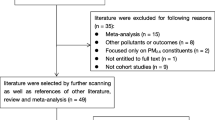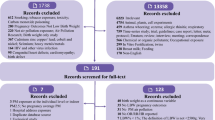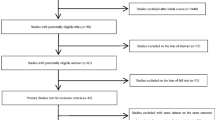Abstract
Increasing number of studies have investigated the impact of maternal exposure to air pollution during pregnancy and adverse birth outcomes, particularly low birth weight (LBW, <2,500 g at birth) and preterm birth (PTB, <37 completed weeks of gestation). We performed a comprehensive review of the peer-reviewed literature and a meta-analysis to quantify the association between maternal exposure to particulate matter with aerodynamic diameter 2.5 and 10 μm (PM2.5 and PM10) during pregnancy and the risk of LBW and PTB. We identified 20 peer-reviewed articles providing quantitative estimate of exposure and outcome that met our selection criteria. There was significant heterogeneity between studies, particularly for findings related to PM10 exposure (LBW, I-squared 54%, p = 0.01; PTB, I-squared = 73%, p < 0.01). Results from random-effect meta-analysis suggested a 9% increase in risk of LBW associated with a 10-μg/m3 increase in PM2.5 (combined odds ratios (OR), 1.09; 95% confidence interval (CI), 0.90–1.32), but our 95% CI included the null value. We estimated a 15% increase in risk of PTB for each 10-μg/m3 increase in PM2.5 (combined OR, 1.15; CI, 1.14–1.16). The magnitude of risk associated with PM10 exposure was smaller (2% per 10-μg/m3 increase) and similar in size for both LBW and PTB, neither reaching formal statistical significance. We observed no significant publication bias, with p > 0.05 based on both Begg's and Egger's bias tests. Our results suggest that maternal exposure to PM, particularly PM2.5 may have adverse effect on birth outcomes. Additional mechanistic studies are needed to understand the underlying mechanisms for this association.



Similar content being viewed by others
References
Aguilera I, Guxens M, Garcia-Esteban R, Corbella T, Nieuwenhuijsen MJ, Foradada CM, Sunyer J (2009) Association between GIS-based exposure to urban air pollution during pregnancy and birth weight in the INMA Sabadell cohort. Environ Health Perspect 117:1322–1327
Alderman BW, Baron AE, Savitz DA (1987) Maternal exposure to neighborhood carbon-monoxide and risk of low infant birth-weight. Public Health Rep 102:410–414
Begg CB, Mazumdar M (1994) Operating characteristics of a rank correlation test for publication bias. Biometrics 50:1088–1101
Bell ML, Ebisu K, Belanger K (2007) Ambient air pollution and low birth weight in Connecticut and Massachusetts. Environ Health Perspect 115:1118–1124
Bobak M (2000) Outdoor air pollution, low birth weight, and prematurity. Environ Health Perspect 108:173–176
Bobak M, Leon DA (1999a) Pregnancy outcomes and outdoor air pollution: an ecological study in districts of the Czech Republic 1986–8. Occup Environ Med 56:539–543
Bobak M, Leon DA (1999b) The effect of air pollution on infant mortality appears specific for respiratory causes in the postneonatal period. Epidemiology 10:666–670
Brauer M, Lencar C, Tamburic L, Koehoorn M, Demers P, Karr C (2008) A cohort study of traffic-related air pollution impacts on birth outcomes. Environ Health Perspect 116:680–686
Chen L, Yang W, Jennison BL, Goodrich A, Omaye ST (2002) Air pollution and birth weight in northern Nevada, 1991–1999. Inhal Toxicol 14:141–157
Choi H, Rauh V, Garfinkel R, Tu YS, Perera FP (2008) Prenatal exposure to airborne polycyclic aromatic hydrocarbons and risk of intrauterine growth restriction. Environ Health Perspect 116:658–665
Crider KS, Whitehead N, Buus RM (2005) Genetic variation associated with preterm birth: a huge review. Genet Med 7:593–604
Currie J, Walker R (2009) Traffic congestion and infant health: evidence from E-ZPass. 15413. NBER Working Paper Series. Report. National Bureau of Economic Research, Cambridge, MA
Dejmek J, Selevan SG, Benes I, Solansky I, Sram RJ (1999) Fetal growth and maternal exposure to particulate matter during pregnancy. Environ Health Perspect 107:475–480
Dejmek J, Solansky I, Benes I, Lenicek J, Sram RJ (2000) The impact of polycyclic aromatic hydrocarbons and fine particles on pregnancy outcome. Environ Health Perspect 108:1159–1164
DerSimonian R, Laird N (1986) Meta-analysis in clinical trials. Control Clin Trials 7:177–188
Dietz PM, England LJ, Callaghan WM, Pearl M, Wier ML, Kharrazi M (2007) A comparison of LMP-based and ultrasound-based estimates of gestational age using linked California livebirth and prenatal screening records. Paediatr Perinat Epidemiol 21:62–71
Egger M, Davey SG, Schneider M, Minder C (1997) Bias in meta-analysis detected by a simple, graphical test. BMJ 315:629–634
Engel SAM, Erichsen HC, Savitz DA, Thorp J, Chanock SJ, Olshan AF (2005) Risk of spontaneous preterm birth is associated with common proinflammatory cytokine polymorphisms. Epidemiology 16:469–477
Fell DB, Dodds L, King WD (2004) Residential mobility during pregnancy. Paediatr Perinat Epidemiol 18:408–414
Ghosh R, Rankin J, Pless-Mulloli T, Glinianaia S (2007) Does the effect of air pollution on pregnancy outcomes differ by gender? A systematic review. Environ Res 105:400–408
Gilboa SM, Mendola P, Olshan AF, Langlois PH, Savitz DA, Loomis D, Herring AH, Fixler DE (2005) Relation between ambient air quality and selected birth defects, seven county study, Texas, 1997–2000. Am J Epidemiol 162:238–252
Glinianaia SV, Rankin J, Bell R, Pless-Mulloli T, Howel D (2004) Particulate air pollution and fetal health a systematic review of the epidemiologic evidence. Epidemiology 15:36–45
Goldenberg RL, Culhane JF, Iams JD, Romero R (2008) Preterm birth 1—epidemiology and causes of preterm birth. Lancet 371:75–84
Gouveia N, Bremner SA, Novaes HMD (2004) Association between ambient air pollution and birth weight in Sao Paulo, Brazil. J Epidemiol Community Health 58:11–17
Ha EH, Hong YC, Lee BE, Woo BH, Schwartz J, Christiani DC (2001) Is air pollution a risk factor for low birth weight in Seoul? Epidemiology 12:643–648
Heinrich J, Slama R (2007) Fine particles, a major threat to children. Int J Hyg Environ Health 210:617–622
Higgins JP, Thompson SG (2002) Quantifying heterogeneity in a meta-analysis. Stat Med 21:1539–1558
Huynh M, Woodruff TJ, Parker JD, Schoendorf KC (2006) Relationships between air pollution and preterm birth in California. Paediatr Perinat Epidemiol 20:454–461
Jalaludin B, Mannes T, Morgan G, Lincoln D, Sheppeard V, Corbett S (2007) Impact of ambient air pollution on gestational age is modified by season in Sydney. Australia, Environmental Health, 6
Kannan S, Misra DP, Dvonch JT, Krishnakumar A (2006) Exposures to airborne particulate matter and adverse perinatal outcomes: a biologically plausible mechanistic framework for exploring potential effect modification by nutrition. Environ Health Perspect 114:1636–1642
Keelan JA, Blumenstein M, Helliwell RJA, Sato TA, Marvin KW, Mitchell MD (2003) Cytokines, prostaglandins and parturition—a review. Placenta 24:S33–S46
Kharrazi M, DeLorenze GN, Kaufman FL, Eskenazi B, Bernert JT, Graham S, Pearl M, Pirkle J (2004) Environmental tobacco smoke and pregnancy outcome. Epidemiology 15:660–670
Landgren O (1996) Environmental pollution and delivery outcome in southern Sweden: a study with central registries. Acta Paediatr 85:1361–1364
Lee BE, Ha EH, Park HS, Kim YJ, Hong YC, Kim H, Lee JT (2003) Exposure to air pollution during different gestational phases contributes to risks of low birth weight. Hum Reprod 18:638–643
Leem JH, Kaplan BM, Shim YK, Pohl HR, Gotway CA, Bullard SM, Rogers JF, Smith MM, Tylenda CA (2006) Exposures to air pollutants during pregnancy and preterm delivery. Environ Health Perspect 114:905–910
Leonardi-Bee J, Smyth A, Britton J, Coleman T (2008) Environmental tobacco smoke and fetal health: systematic review and meta-analysis. Arch Dis Child Fetal Neonatal Ed 93:F351–F361
Lin CM, Li CY, Mao IF (2004a) Increased risks of term low-birth-weight infants in a petrochemical industrial city with high air pollution levels. Arch Environ Health 59:663–668
Lin CM, Li CY, Yang GY, Mao IF (2004b) Association between maternal exposure to elevated ambient sulfur dioxide during pregnancy and term low birth weight. Environ Res 96:41–50
Lynch CD, Zhang J (2007) The research implications of the selection of a gestational age estimation method. Paediatr Perinat Epidemiol 21:86–96
Maisonet M, Bush TJ, Correa A, Jaakkola JJK (2001) Relation between ambient air pollution and low birth weight in the northeastern United States. Environ Health Perspect 109:351–356
Maisonet M, Correa A, Misra D, Jaakkola JJ (2004) A review of the literature on the effects of ambient air pollution on fetal growth. Environ Res 95:106–115
Medeiros A, Gouveia N (2005) Relationship between low birthweight and air pollution in the city of Sao Paulo, Brazil. Rev Saúde Pública 39:965–972
Mills NL, Donaldson K, Hadoke PW, Boon NA, MacNee W, Cassee FR, Sandstrom T, Blomberg A, Newby DE (2009) Adverse cardiovascular effects of air pollution. Nat Clin Pract Cardiovasc Med 6:36–44
Olsen J (2005) The Danish national birth cohort—a data source for studying preterm birth. Acta Obstet Gynecol Scand 84:539–540
Olsen J, Basso O (2005) Reproductive epidemiology. In: Ahrens W, Pigeot I (eds) Handbook of epidemiology. Springer, Berlin, pp 1043–1109
Osmond C, Barker DJP (2000) Fetal, infant, and childhood growth are predictors of coronary heart disease, diabetes, and hypertension in adult men and women. Environ Health Perspect 108:545–553
Parker JD, Woodruff TJ (2008) Influences of study design and location on the relationship between particulate matter air pollution and birthweight. Paediatr Perinat Epidemiol 22:214–227
Parker JD, Mendola P, Woodruff TJ (2008) Preterm birth after the Utah Valley steel mill closure a natural experiment. Epidemiology 19:820–823
Petitti DB (2001) Approaches to heterogeneity in meta-analysis. Stat Med 20:3625–3633
Pope CA (1996) Particulate pollution and health: a review of the Utah Valley experience. J Expo Anal Environ Epidemiol 6:23–34
Ricciardi C, Guastadisegni C (2003) Environmental inequities and low birth weight. Ann Ist Super Sanità 39:229–234
Ritz B, Yu F (1999) The effect of ambient carbon monoxide on low birth weight among children born in southern California between 1989 and 1993. Environ Health Perspect 107:17–25
Ritz B, Yu F, Chapa G, Fruin S (2000) Effect of air pollution on preterm birth among children born in Southern California between 1989 and 1993. Epidemiology 11:502–511
Ritz B, Yu F, Fruin S, Chapa G, Shaw GM, Harris JA (2002) Ambient air pollution and risk of birth defects in southern California. Am J Epidemiol 155:17–25
Ritz B, Wilhelm M, Hoggatt KJ, Ghosh JKC (2007) Ambient air pollution and preterm birth in the environment and pregnancy outcomes study at the University of California, Los Angeles. Am J Epidemiol 166:1045–1052
Rogers JF, Dunlop AL (2006) Air pollution and very low birth weight infants: a target population? Pediatrics 118:156–164
Rubes J, Selevan SG, Evenson DP, Zudova D, Vozdova M, Zudova Z, Robbins WA, Perreault SD (2005) Episodic air pollution is associated with increased DNA fragmentation in human sperm without other changes in semen quality. Hum Reprod 20:2776–2783
Rudra CB, Williams MA, Frederick IO, Luthy DA (2006) Maternal asthma and risk of preeclampsia—a case-control study. J Reprod Med 51:94–100
Sagiv SK, Mendola P, Loomis D, Herring AH, Neas LM, Savitz DA, Poole C (2005) A time-series analysis of air pollution and preterm birth in Pennsylvania, 1997–2001. Environ Health Perspect 113:602–606
Salam MT, Millstein J, Li YF, Lurmann FW, Margolis HG, Gilliland FD (2005) Birth outcomes and prenatal exposure to ozone, carbon monoxide, and particulate matter: results from the children's health study. Environ Health Perspect 113:1638–1644
Selevan SG, Kimmel CA, Mendola P (2000) Identifying critical windows of exposure for children's health. Environ Health Perspect 108:451–455
Slama R, Morgenstern V, Cyrys J, Zutavern A, Herbarth O, Wichmann HE, Heinrich J, LISA Study Group (2007) Traffic-related atmospheric pollutants levels during pregnancy and offspring's term birth weight: a study relying on a land-use regression exposure model. Environ Health Perspect 115:1283–1292
Slama R, Thiebaugeorges O, Goua V, Aussel L, Sacco P, Bohet A, Forhan A, Ducot B, Nnesi-Maesano I, Heinrich J, Magnin G, Schweitzer M, Kaminski M, Charles MA (2009) Maternal personal exposure to airborne benzene and intrauterine growth. Environ Health Perspect 117:1313–1321
Sram RJ, Binkova B, Dejmek J, Bobak M (2005) Ambient air pollution and pregnancy outcomes: a review of the literature. Environ Health Perspect 113:375–382
Stillerman KP, Mattison DR, Giudice LC, Woodruff TJ (2008) Environmental exposures and adverse pregnancy outcomes: a review of the science. Reprod Sci 15:631–650
Suh YJ, Ha EH, Park H, Kim YJ, Kim H, Hong YC (2008) GSTM1 polymorphism along with PM10 exposure contributes to the risk of preterm delivery. Mutat Res, Genet Toxicol Environ Mutagen 656:62–67
Suh YJ, Kim H, Seo JH, Park H, Kim YJ, Hong YC, Ha EH (2009) Different effects of PM10 exposure on preterm birth by gestational period estimated from time-dependent survival analyses. Int Arch Occup Environ Health 82:613–621
Wang XB, Ding H, Ryan L, Xu XP (1997) Association between air pollution and low birth weight: a community-based study. Environ Health Perspect 105:514–520
Wilcox AJ (2001) On the importance—and the unimportance—of birthweight. Int J Epidemiol 30:1233–1241
Wilhelm M, Ritz B (2005) Local variations in CO and particulate air pollution and adverse birth outcomes in Los Angeles County, California, USA. Environ Health Perspect 113:1212–1221
Wu J, Ren C, Delfino R, Chung J, Wilhelm M, Ritz B (2009) Association between local traffic-generated air pollution and preeclampsia and preterm delivery in the South Coast air basin of California. Environ Health Perspect 117:1773–1779
Xu XP, Ding H, Wang XB (1995) Acute effects of total suspended particles and sulfur dioxides on preterm delivery: a community-based cohort study. Arch Environ Health 50:407–415
Zeger SL, Thomas D, Dominici F, Samet JM, Schwarz J, Dockery D, Cohen A (2001) Exposure measurement error in time-series studies of air pollution: concepts and consequences. Environ Health Perspect 109:A517 (Vol. 108, p 419, 2000)
Disclaimer
The views expressed in this paper are those of the authors and do not necessarily reflect the views of the Health Effects Institute or its sponsors.
The work was partially supported by a grant for CHERG to the US Fund for UNICEF and for the Global Burden of Diseases, Injuries, and Risk Factors Study. Both grants were from the Bill & Melinda Gates Foundation.
Author information
Authors and Affiliations
Corresponding author
Rights and permissions
About this article
Cite this article
Sapkota, A., Chelikowsky, A.P., Nachman, K.E. et al. Exposure to particulate matter and adverse birth outcomes: a comprehensive review and meta-analysis. Air Qual Atmos Health 5, 369–381 (2012). https://doi.org/10.1007/s11869-010-0106-3
Received:
Accepted:
Published:
Issue Date:
DOI: https://doi.org/10.1007/s11869-010-0106-3




